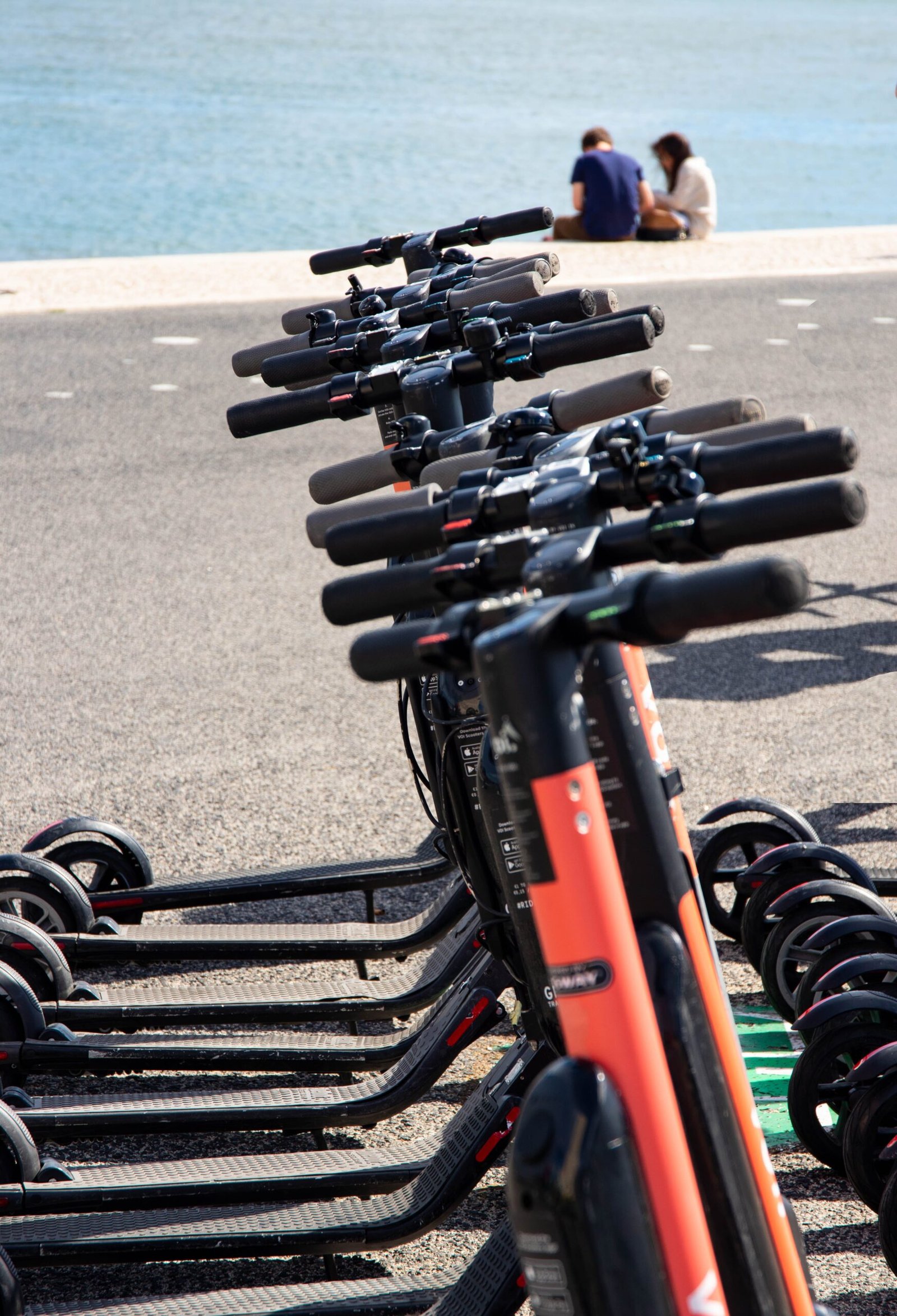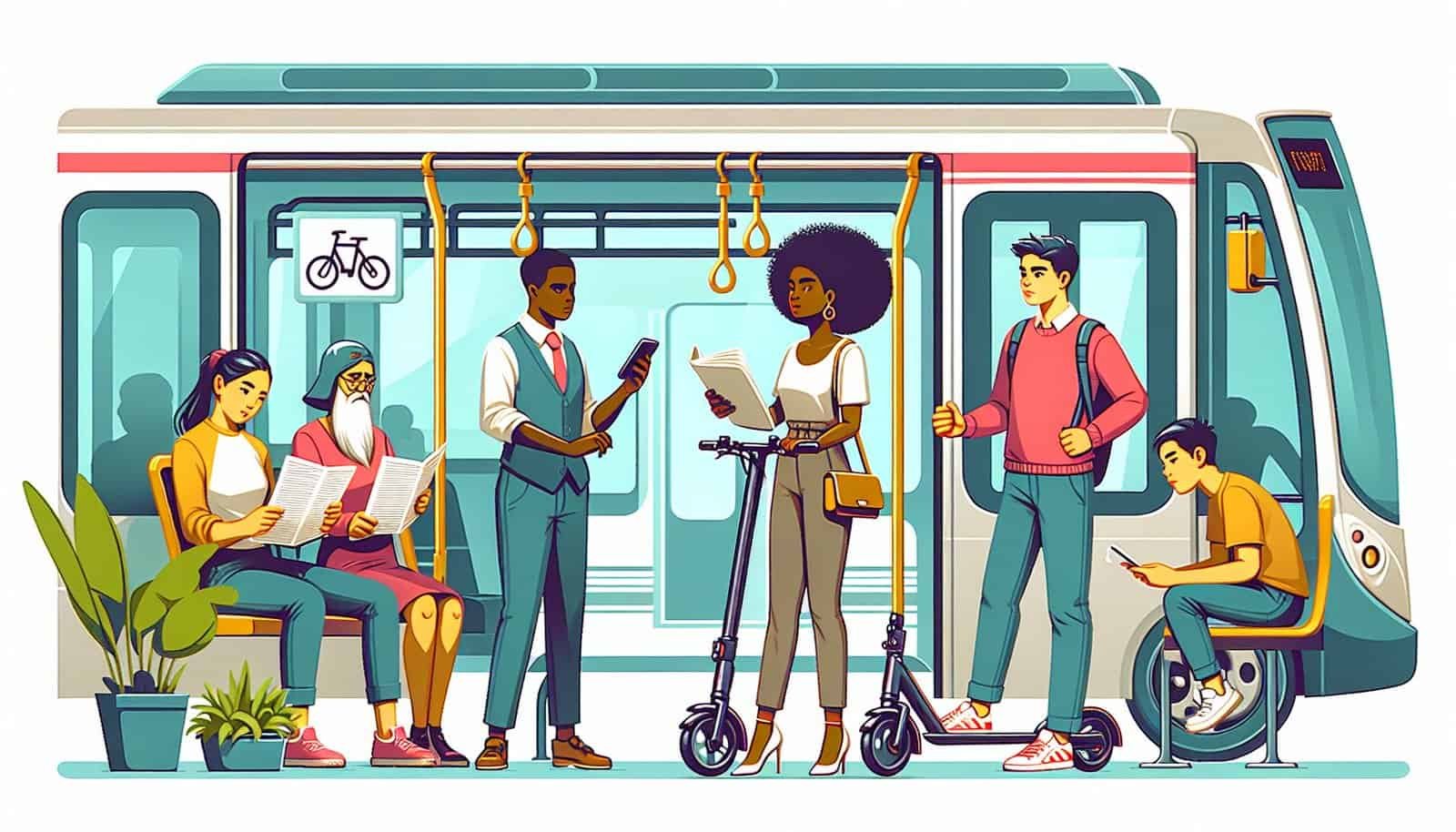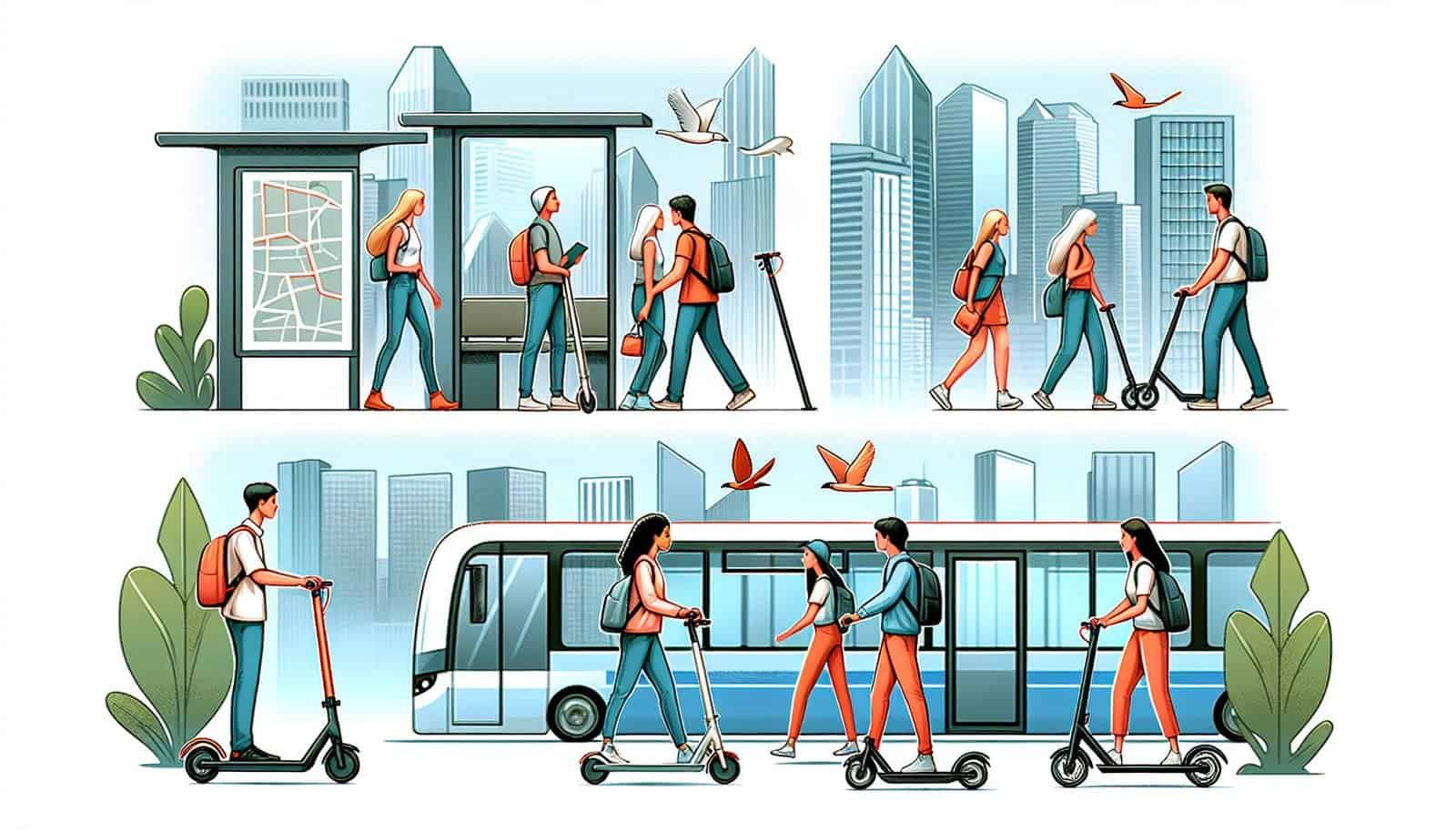Have you ever wondered if it’s possible to bring your electric scooter on public transportation? Whether you’re a daily commuter or simply looking for a convenient way to get around town, this question might have crossed your mind. Well, the good news is that in many cities around the world, electric scooters are indeed allowed on buses and trains! In this article, we’ll explore the regulations and guidelines you need to know in order to confidently hop on public transportation with your beloved electric scooter. Get ready to discover the exciting possibilities and benefits of combining your scooter with the convenience of public transit.

Overview of Electric Scooters
What is an electric scooter?
An electric scooter, also known as an e-scooter, is a mode of transportation powered by an electric motor. It typically consists of a footboard, handlebars, and wheels. Unlike traditional kick scooters, electric scooters run on rechargeable batteries and can reach speeds of up to 15-20 miles per hour. They offer a convenient and eco-friendly way to travel through urban areas, with some models even equipped with additional features such as lights, brakes, and suspension systems.
Types of electric scooters
There are various types of electric scooters available on the market today to cater to different needs and preferences. Some common types include:
- Commuter scooters: These are lightweight and designed for everyday use, making them ideal for short-distance commuting or running errands.
- Folding scooters: As the name suggests, these scooters can be folded, making them incredibly portable and easy to carry around.
- Off-road scooters: These scooters are designed with rugged tires and strong suspension systems, allowing riders to navigate through rough terrains and trails.
- Three-wheel scooters: These scooters offer enhanced stability and balance, making them a popular choice for those who may have difficulty balancing on two wheels.
- Performance scooters: Designed for speed and power, performance scooters can reach higher speeds and cover longer distances on a single charge.
Advantages of electric scooters
Electric scooters come with a range of advantages that make them a popular choice for urban commuters and leisure riders alike. Here are some key benefits:
- Eco-friendly: Electric scooters produce zero emissions, helping to reduce air pollution and combat climate change.
- Cost-effective: Compared to cars or motorcycles, electric scooters are relatively inexpensive to purchase and maintain. They are also more fuel-efficient, saving you money on petrol or gas.
- Convenient and time-saving: Electric scooters provide a hassle-free way to navigate through traffic and crowded urban areas, helping you reach your destination quickly and effortlessly.
- Space-efficient: With their compact size, electric scooters take up minimal space and can be easily parked or stored, even in small apartments or offices.
- Health benefits: Riding an electric scooter can provide a low-impact form of exercise, helping to improve cardiovascular health and strengthen leg muscles.
Rules and Regulations
Local transportation regulations
Before using your electric scooter on public transportation, it is important to familiarize yourself with the local transportation regulations in your area. Different cities and countries may have specific rules and restrictions regarding the use of electric scooters on public roads and transportation systems. Some areas may require scooter riders to have a valid driver’s license, helmet use, or adhere to specific speed limits.
Specific rules for electric scooters
In addition to general transportation regulations, many regions have specific rules pertaining to the use of electric scooters. Some common regulations include:
- Age restrictions: Certain jurisdictions may require riders to be a certain age to operate an electric scooter, often 16 years or older.
- Speed limits: To ensure safety, speed limits may be imposed on electric scooters, especially in crowded areas or near pedestrians.
- Sidewalk usage: In some areas, electric scooters may be prohibited from riding on sidewalks, requiring riders to use designated bike lanes or roads.
- Helmet requirements: Helmets may be mandatory for electric scooter riders to enhance safety and prevent head injuries in the event of an accident.
It is essential to research and abide by the specific rules and regulations in your locality to ensure a safe and legal experience when using your electric scooter on public transportation.
Permitted modes of transportation
The permissibility of using electric scooters on public transportation, such as buses and trains, varies from city to city. While some regions have embraced the integration of electric scooters as a viable mode of transportation, others may still be in the process of developing regulations and infrastructure to accommodate them. It is crucial to check with local transportation authorities or consult their websites to determine the permitted modes of transport for electric scooters in your area.
Public Transportation Policies
Public transportation policies for electric scooters
Public transportation policies regarding electric scooters can vary significantly depending on the city or country. While some regions have specific guidelines in place, others may still be formulating regulations as electric scooters gain popularity. Public transportation policies often address concerns such as rider safety, impact on other passengers, and the integration of electric scooters into existing transportation systems.
Availability and accessibility of public transportation for electric scooters
In many cities, efforts are being made to increase the accessibility and availability of public transportation for electric scooters. This includes providing designated areas for scooter parking at public transportation hubs, ensuring the infrastructure supports safe boarding and disembarking, and integrating electric scooters into existing public transportation apps or systems for seamless travel planning.
Integration of electric scooters on public transportation
To enhance the convenience and versatility of public transportation, some cities have implemented programs to allow electric scooters on buses and trains. This integration can provide riders with an excellent solution for the first and last mile of their journeys, bridging the gap between their homes or workplaces and public transportation hubs. The specifics of this integration vary by location, and it is important for riders to familiarize themselves with the policies and guidelines enforced in their area.
Using Electric Scooters on Buses
Can electric scooters be taken on buses?
The permissibility of bringing electric scooters on buses depends on the policies of the specific transportation agency or company operating the buses. While some regions may allow electric scooters on buses, others may have restrictions or requirements that need to be met.
Specific rules and requirements for using electric scooters on buses
For regions that permit electric scooters on buses, there are often specific rules and requirements that must be followed for the safety and convenience of all passengers. These may include:
- Size and weight limitations: Electric scooters being brought onto buses may need to meet specific size and weight requirements to ensure they can be accommodated safely.
- Folding requirement: In some cases, electric scooters may be required to be foldable, allowing them to be stored in designated areas or in accessible spaces within the bus.
- Securing the scooter: To prevent accidents or damage during transit, regulations may dictate that electric scooters must be safely secured or stored to avoid movement or shifting.
It is essential that riders research and comply with the rules enforced by the specific public transportation agency or company when using electric scooters on buses.
Safety considerations and accommodations
Using electric scooters on buses requires careful attention to safety considerations for both the rider and other passengers. Some safety tips to keep in mind include:
- Stabilize your scooter: If permitted, secure your electric scooter in the designated area or hold it in a way that ensures it is stable and won’t fall or shift during the bus ride.
- Respect personal space: Be mindful of other passengers and their personal space. Avoid obstructing pathways or blocking seats with your scooter.
- Follow the driver’s instructions: If the bus driver provides specific instructions or guidelines regarding the placement or handling of your electric scooter, be sure to comply for the safety and convenience of everyone on board.

Using Electric Scooters on Trains
Can electric scooters be taken on trains?
The permissibility of bringing electric scooters on trains varies depending on the policies and regulations of the specific train company or transportation authority operating the trains. It is crucial to research and comply with the rules enforced in your area.
Specific rules and requirements for using electric scooters on trains
For regions that allow electric scooters on trains, there may be specific rules and requirements that must be followed to ensure a safe and smooth journey. Some common rules include:
- Size limitations: Electric scooters being brought onto trains may need to meet size restrictions to ensure they can be accommodated within the available space.
- Folding requirement: In many cases, electric scooters must be foldable to minimize space consumption and allow for easier storage on trains.
- Time restrictions: Some transportation authorities may have specific time restrictions during which electric scooters are permitted on trains, typically during off-peak hours to minimize congestion.
Safety considerations and accommodations
When using electric scooters on trains, it is essential to prioritize safety and make any necessary accommodations to avoid inconveniencing other passengers. Here are some safety considerations to keep in mind:
- Fold and secure: If required, fold your electric scooter and secure it in the designated storage areas or compartments provided on the train.
- Avoid blocking pathways: Ensure that your scooter is not obstructing pathways or creating obstacles for other passengers to navigate through the train.
- Be mindful of crowded trains: During peak hours or on crowded trains, it may be challenging to bring your electric scooter on board. Consider alternative modes of transport during these times or wait for a less crowded train to ensure a comfortable journey for all passengers.

Alternatives to Public Transportation for Electric Scooters
Alternative transportation options for electric scooters
While public transportation can be a convenient option for electric scooter users, it is also essential to consider alternative transportation methods that may better suit your needs. Some alternatives to public transportation for electric scooters include:
- Bike lanes and routes: Many cities now have dedicated bike lanes and routes that can be utilized by electric scooters, providing a safe and efficient means of travel.
- Personal electric scooter trips: Depending on the distance and road conditions, you may consider using your electric scooter for the entire journey, eliminating the need for public transportation.
- Bike-sharing programs: In cities where bike-sharing programs exist, electric scooter users can potentially benefit from these services by renting a bicycle for longer trips or when public transportation is not an ideal option.
Electric scooter-friendly routes and infrastructure
As the popularity of electric scooters grows, more cities are investing in infrastructure and designing routes that cater specifically to electric scooter riders. These may include dedicated lanes, charging stations, and scooter parking areas. Research your local area to identify electric scooter-friendly routes or facilities that can enhance your overall riding experience.
Recommendations for efficient traveling
To optimize your travel experience with an electric scooter, here are some recommendations for efficient traveling:
- Plan your routes: Utilize available maps or smartphone applications to plan efficient routes that maximize the use of dedicated scooter lanes or bike-friendly roads.
- Charge your scooter: Ensure your electric scooter is fully charged before embarking on your journey to avoid unexpected disruptions or delays due to battery depletion.
- Time management: Factor in the time needed for charging or refueling stops when planning your trips to ensure you reach your destination on time.
Benefits and Limitations
Benefits of using electric scooters on public transportation
Combining electric scooters with public transportation offers several benefits:
- Flexibility: Electric scooters provide a convenient last-mile solution, allowing you to extend the reach of public transportation and access areas that may have limited transportation options.
- Time-saving: By using electric scooters in conjunction with public transportation, you can avoid traffic congestion and reach your destination more quickly, especially during rush hours.
- Cost-effective: Electric scooters are an affordable transportation option, reducing the need for expensive car ownership or other forms of private transport.
- Eco-friendly: Electric scooters produce zero emissions and have a much lower environmental impact compared to traditional vehicles, contributing to a cleaner and greener environment.
- Health benefits: Riding an electric scooter, even for short distances, provides an opportunity for physical activity, helping to improve fitness and overall well-being.
Limitations and challenges of combining electric scooters and public transportation
While the combination of electric scooters and public transportation offers numerous advantages, it also presents certain limitations and challenges:
- Infrastructure limitations: Not all cities or regions have adequate infrastructure, such as dedicated scooter lanes or safe storage areas, to support the integration of electric scooters with public transportation.
- Availability limitations: Depending on the location, the availability of public transportation options or the presence of electric scooters may be limited, affecting the feasibility of combining the two modes of transport.
- Capacity constraints: During peak hours or on crowded public transportation, there may be limitations on the number of electric scooters that can be accommodated, leading to potential inconvenience or restrictions for riders.
- Range limitations: Electric scooters generally have a limited range compared to other modes of transportation. Depending on the distance of your journey, you may need to consider the need for recharging or alternative transportation options.
Considerations for selecting the most suitable transportation mode
When deciding whether to combine your electric scooter use with public transportation, consider the following factors:
- Distance: Evaluate the distance you need to travel and determine if using an electric scooter alone or in combination with public transportation is the most efficient and practical option.
- Local regulations: Familiarize yourself with the rules regarding electric scooter use and transportation policies in your area to ensure compliance and a smooth travel experience.
- Time constraints: Assess your available time and consider the potential impact of using electric scooters and public transportation on your overall travel time.

Tips for Using Electric Scooters on Public Transportation
Tips for a smooth experience using electric scooters on public transportation
To ensure a smooth experience when using your electric scooter on public transportation, consider the following tips:
- Plan your journey: Before starting your trip, research the schedules and routes of buses or trains to align them with your electric scooter’s capabilities and charging needs.
- Pack essentials: Carry a helmet, charger, and any necessary accessories with you to ensure safety and convenience, especially if your journey involves multiple modes of transport.
- Be considerate: Respect other passengers by avoiding excessive noise or aggressive maneuvering. Follow any instructions or guidelines provided by the transportation staff.
- Communicate with drivers: If in doubt, consult the bus or train driver for information on how to safely board or store your electric scooter.
- Practice safe storage: When storing your scooter on public transportation, ensure it is secure and won’t cause a hazard to yourself or other passengers.
Etiquette and best practices
Adhering to proper etiquette and best practices when using your electric scooter on public transportation is essential to create a positive experience for everyone involved. Some etiquette tips to keep in mind include:
- Respect personal space: Avoid blocking aisleways or seating areas with your scooter. Be mindful of other passengers and their comfort.
- Prioritize accessibility: If there are limited spaces available for storing your electric scooter, give priority to passengers with mobility issues or those who require the designated space.
- Queue patiently: Maintaining a respectful and patient attitude when boarding or alighting from public transportation ensures a smooth and efficient experience for all passengers.
Maintenance and care for your electric scooter
Regular maintenance and care for your electric scooter will ensure its optimal performance and longevity. Some maintenance tips to consider include:
- Regular cleaning: Keep your electric scooter clean by wiping it down after rides and removing any dirt or debris that may accumulate over time.
- Charging routine: Establish a regular charging routine to maintain the battery’s health and prolong its lifespan. Follow the manufacturer’s instructions for charging intervals and techniques.
- Inspections: Regularly inspect your electric scooter for any signs of wear and tear, loose bolts, or faulty components. Address any issues promptly to prevent further damage or safety hazards.
- Tire maintenance: Check your tire pressure regularly and make sure they are properly inflated to ensure a smooth and safe ride.
Case Studies
Successful implementation of electric scooters on public transportation systems
Several cities worldwide have successfully integrated electric scooters into their public transportation systems, providing case studies for others to emulate. For example:
- Barcelona, Spain: The city has implemented a dockless electric scooter-sharing system, allowing users to easily access scooters near major transportation hubs. This integration has provided residents and visitors with a convenient and sustainable transportation option.
- Paris, France: Paris has introduced dedicated scooter lanes and infrastructure, making it easy for riders to combine electric scooters with public transportation. This has led to increased scooter usage and a reduction in car trips.
Cities promoting the use of electric scooters on buses and trains
To encourage the use of electric scooters on buses and trains, several cities have implemented initiatives and policies to support this integration. Some notable examples include:
- San Francisco, USA: The city has established guidelines for the use of electric scooters on buses, allowing riders to seamlessly transition between scooters and buses for their daily commutes.
- Helsinki, Finland: Helsinki has implemented a city-wide program that provides electric scooters as a shared mobility service at public transportation stations, enabling last-mile connectivity for residents and visitors.
User experiences and feedback
User experiences and feedback regarding the combination of electric scooters and public transportation have been largely positive. Many riders appreciate the convenience, cost-effectiveness, and reduced environmental impact of this combined transportation approach. Feedback typically highlights the seamless integration of scooters with public transportation systems and the overall time-saving benefits.

Conclusion
Combining electric scooters with public transportation offers numerous benefits, including increased flexibility, reduced travel time, and improved environmental sustainability. However, it is essential for riders to familiarize themselves with local regulations and transportation policies to ensure a safe and legal experience. As cities continue to develop infrastructure and implement initiatives to support electric scooter integration, the future looks promising for this innovative mode of transportation. Recommended further research includes in-depth studies on infrastructure development, safety standards, and user behavior analysis to continue improving the integration of electric scooters with public transportation systems.

